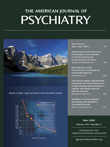Are High-Risk Haplotypes in DTNBP1 and NRG1 Resistance Genes for Schizophrenia?
To The Editor:
Recently, several candidate susceptibility genes of small effects for schizophrenia have been replicated in association studies. However, their possible roles in the manifestation of the disease remain obscure (1) . Therefore, we read with great interest the article by Ayman H. Fanous, M.D., and colleagues (2) , which described the relationship between a high-risk haplotype in the DTNBP1 gene and clinical features of schizophrenia. The conclusion—that the etiologically relevant variation in DTNBP1 in presumptive linkage disequilibrium with the high-risk haplotype might be associated with high levels of negative symptoms—was derived from the observation that the high-risk haplotype frequency was higher in the subjects in the upper 40th percentile for the negative symptom factor.
However, the data in their Table 2 might suggest the opposite possibility. First, the frequency of the high-risk haplotype was higher in the upper 20%–40% subgroup for the negative symptom factor than in the upper 0%–20% subgroup (0.098 and 0.075, respectively). In addition, the high-risk haplotype frequencies in the upper 40% subgroup for four factors (negative, hallucinations, delusions, and manic) were higher in the broad-definition group than in the narrow-definition group. These results suggest that the high-risk haplotype in DTNBP1 was overtransmitted to the milder cases with schizophrenia, which is just the opposite of their interpretation.
This might be the same with NRG1 , another best-replicated positional candidate gene for schizophrenia. The high-risk haplotypes were associated with nondeficit schizophrenia but not with deficit schizophrenia (3) .
A significant p value in an association study tells us nothing about the nature of the causal relationship between the gene and the disease (1) . Therefore, it should be noted that a significant positive association with a disease does not necessarily imply susceptibility but rather may indicate resistance to the disease.
According to Kendler (4) , one of the most perplexing problems concerned with the schizophrenia- DTNBP1 connection is that although reduced levels of DTNBP1 were seen in the hippocampus of nearly all affected cases, only a subset of individuals with schizophrenia carries the high-risk DTNBP1 haplotypes that reduce DTNBP1 expression in the brain (5) . However, if the high-risk haplotypes in DTNBP1 were resistance genes and a reduced DTNBP1 level in the brain was a resistance response to the pathogenesis of the disease, the brains of most patients would show such a change and a subset of patients who carry apparent high-risk DTNBP1 haplotypes should have a genetically determined resistance that makes the disease milder.
1. Kendler KS: “A gene for…”: the nature of gene action in psychiatric disorders. Am J Psychiatry 2005; 162:1243–1252Google Scholar
2. Fanous AH, van den Oord EJ, Riley BP, Aggen SH, Neale MC, O’Neill FA, Walsh D, Kendler KS: Relationship between a high-risk haplotype in the DTNBP1 (dysbindin) gene and clinical features of schizophrenia. Am J Psychiatry 2005; 162:1824–1832 Google Scholar
3. Bakker SC, Hoogendoorn MLC, Selten J-P, Verduijn W, Pearson PL, Sinke RJ, Kahn RS: Neuregulin 1: genetic support for schizophrenia subtypes. Mol Psychiatry 2004; 9:1061–1063Google Scholar
4. Kendler KS: Schizophrenia genetics and dysbindin: a corner turned? (editorial). Am J Psychiatry 2004; 161:1533–1536Google Scholar
5. Bray NJ, Preece A, Williams NM, Moskvina V, Buckland PR, Owen MJ, O’Donovan MC: Haplotypes at the dystrobrevin binding protein 1 (DTNBP1) gene locus mediate risk for schizophrenia through reduced DTNBP1 expression. Hum Mol Genetics 2005; 14:1947–1954Google Scholar



